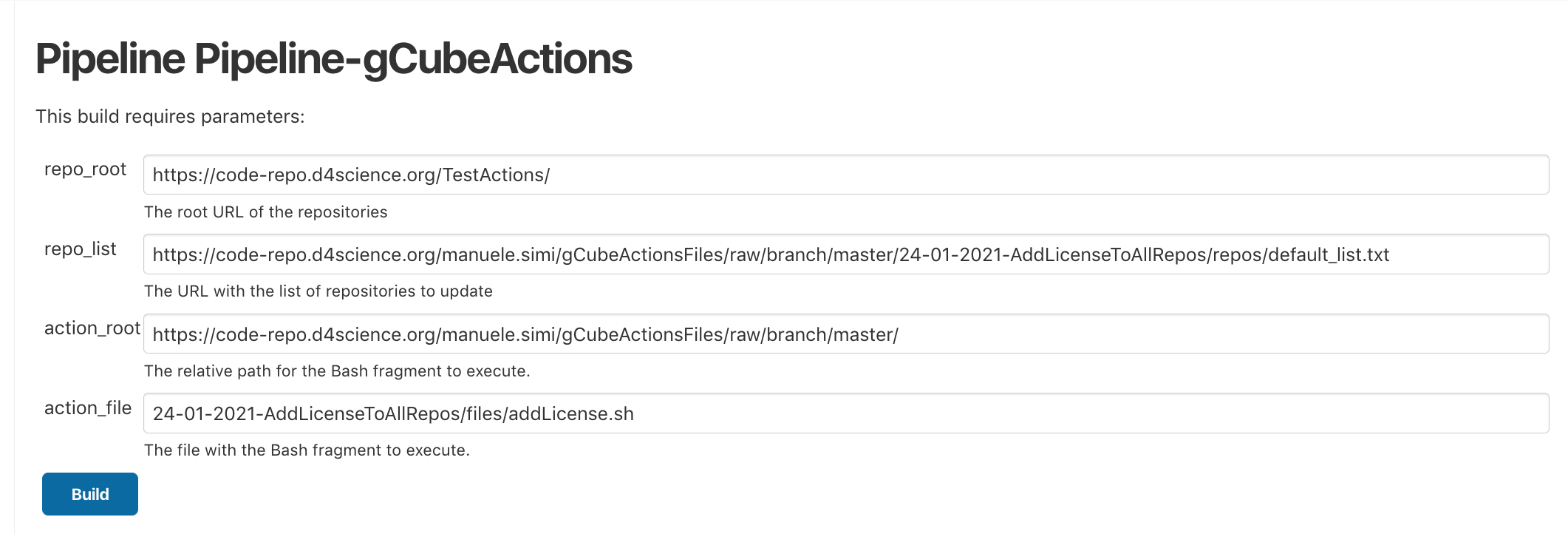Difference between revisions of "Continuous Integration: Tagging Jenkins Pipeline"
From Gcube Wiki
Manuele.simi (Talk | contribs) |
Manuele.simi (Talk | contribs) |
||
| Line 1: | Line 1: | ||
= gCubeTagging Pipeline Project = | = gCubeTagging Pipeline Project = | ||
| + | A pipeline to execute configurable actions over a list of Git repositories: | ||
| − | + | The pipeline project is available at: https://jenkins.d4science.org/job/Pipeline-gCubeActions/ | |
| − | https://jenkins.d4science.org/job/Pipeline- | + | |
== Parameters== | == Parameters== | ||
| − | [[File: | + | [[File:Jenkins_action_pipeline_params.png|400px]] |
| − | |||
| − | |||
| − | |||
| − | |||
== Triggers == | == Triggers == | ||
No triggers are defined because the pipeline is expected to be manually launched by the [[Continuous_Integration:_Releases_Manager|Release Manager]]: | No triggers are defined because the pipeline is expected to be manually launched by the [[Continuous_Integration:_Releases_Manager|Release Manager]]: | ||
| − | |||
| − | |||
| − | |||
== Git == | == Git == | ||
| Line 30: | Line 23: | ||
= Jenkins Pipeline Definition = | = Jenkins Pipeline Definition = | ||
== Git Repository == | == Git Repository == | ||
| − | The definition of the gCube release pipeline is maintained in this Git Repository: | + | The definition of the gCube release pipeline is maintained in this Git Repository: ... |
== Requirements on Jenkins == | == Requirements on Jenkins == | ||
| − | + | ||
| − | + | ||
| − | + | ||
| − | + | ||
| − | + | ||
| − | + | ||
| − | + | ||
= Jenkins Pipeline Execution = | = Jenkins Pipeline Execution = | ||
| − | |||
| − | |||
| − | |||
| − | |||
| − | |||
| − | |||
| − | |||
| − | |||
| − | |||
| − | |||
| − | |||
| − | |||
| − | |||
| − | |||
| − | |||
| − | |||
| − | |||
| − | |||
| − | |||
| − | |||
| − | |||
| − | |||
| − | |||
| − | |||
| − | |||
| − | |||
| − | |||
| − | |||
| − | |||
| − | |||
| − | = | + | = Action Report = |
If the pipeline execution succeeds, it sends a tag report to the release manager. | If the pipeline execution succeeds, it sends a tag report to the release manager. | ||
The report includes the following information for each Git repository tagged: | The report includes the following information for each Git repository tagged: | ||
| − | * the | + | * the repo name |
| − | + | ||
* the SCM url | * the SCM url | ||
| − | * the | + | * the result (completed or failed) |
| − | + | ||
| − | + | ||
Here's an example of a tag report: | Here's an example of a tag report: | ||
| − | [[File:Jenkins- | + | [[File:Jenkins-action-report.png|600px]] |
''Back to the [[Continuous_Integration_procedure_(2019) | CI guide]].'' | ''Back to the [[Continuous_Integration_procedure_(2019) | CI guide]].'' | ||
[[Category:Continuous_Integration]] | [[Category:Continuous_Integration]] | ||
Revision as of 04:37, 26 January 2021
Contents
gCubeTagging Pipeline Project
A pipeline to execute configurable actions over a list of Git repositories:
The pipeline project is available at: https://jenkins.d4science.org/job/Pipeline-gCubeActions/
Parameters
Triggers
No triggers are defined because the pipeline is expected to be manually launched by the Release Manager:
Git
The pipeline is maintained in a Git repository. This section connects the project to the Git repository.
Jenkins Pipeline Definition
Git Repository
The definition of the gCube release pipeline is maintained in this Git Repository: ...
Requirements on Jenkins
Jenkins Pipeline Execution
Action Report
If the pipeline execution succeeds, it sends a tag report to the release manager. The report includes the following information for each Git repository tagged:
- the repo name
- the SCM url
- the result (completed or failed)
Here's an example of a tag report:
Back to the CI guide.


